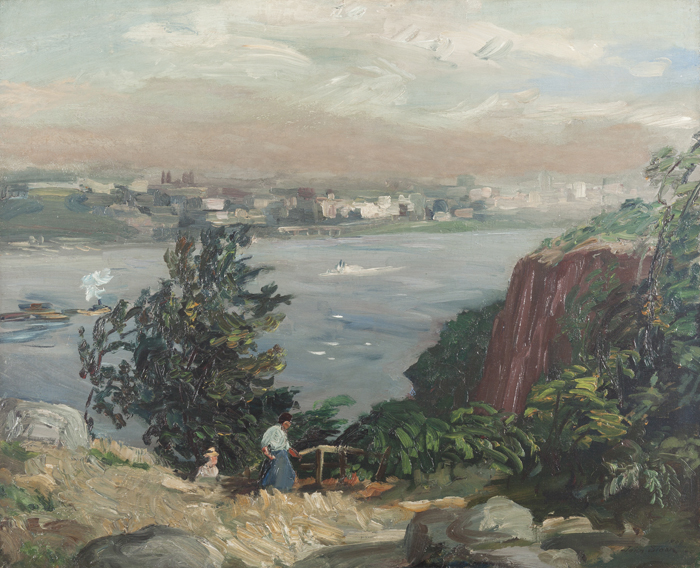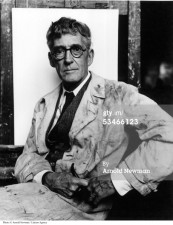
John French Sloan
American, 1871-1951
City from the Palisades, 1908
oil on canvas
26 1/8 x 32 1/8 in.
SBMA, Gift of Mrs. Sterling Morton to the Preston Morton Collection
1960.82

John French Sloan, Self-Portrait, 1917–1922, Oil on canvas, 24 1/8 x 20 in. (61.3 x 50.8 cm.), Gift of Helen Farr Sloan, 1973.15, The Pennsylvania Academy of the Fine Arts
As he wrote in The Gist of Art:
“Though a living cannot be made at art, art makes living worthwhile. It makes living, living. It makes starving living. It makes worry, it makes trouble, it makes a life that would be barren of everything-living. It brings life to life.” - John Sloan
RESEARCH PAPER
Called “Johnny” by most everyone and “Sloan” by his wife, Dolly, John Sloan is most remembered for his place in the American urban realist group of painters called the “Ashcan” school. This moniker, which did not emerge until the 1930s, is suggestive of the group’s tendency towards dark colors and interest in the ragtag vigor of the working class. Initiated by a group of talented young artists, it was the first significant movement in the development of a truly American art at the turn of the 20th century. Rejecting the conservative aesthetics represented by the National Academy of Design, they were intent on capturing the grittiness of the urban frontier, burgeoning with the new immigrant influx and the vibrancy of the crowded streets. They were rebels, art revolutionaries who indelibly transformed the face of art in America just as the Impressionists had in Europe several decades earlier.
Though this short-lived movement is considered the hallmark of Sloan’s career, his art profile is amazingly broad. He was a superb printmaker, (dubbed “the American Hogarth” for his superb etchings), a major innovator in the Poster style of the late nineteenth century, a political cartoonist (often under the anagrammatic “Josh Nolan”), an illustrator par excellence, a painter of the desert landscape and, not least, a beloved teacher at the Art Students’ League in New York City for twenty-two years.
Born into a modest home in Lock Haven, Pennsylvania in 1871, he taught himself to etch at age seventeen. Subsequently, he worked both as a freelancer as well as a newspaper illustrator at the Philadelphia Inquirer before the advent of photography extinguished that dying art. In 1892, he enrolled at The Pennsylvania Academy of Fine Arts and by 1906, had moved to New York and was working as an illustrator. It was in New York that Sloan became serious about painting the life that he found on the streets. He painted from memory or from quick sketches and finished them with a set, limited palette in his studio.
As a member of “The Eight,”1 Sloan and his peers revolted against the conservatism of The Academy with an “outlaw salon” that had its first show at the Macbeth Gallery on February 3rd, 1907. It was a marked success, traveling to many American cities, and credited as “the first genuine expression in the visual arts of a national coming-of-age, a separation from European-derived academic rules”2 The critical reaction was disparate and often theatrical, with one voice decrying, “Is it fine art to exhibit our sores?”3
The Macbeth show presaged the famous Armory Show of 1913 that introduced new European art to the American public as well as promoted an entirely new American art. It was also a turning point in the life of John Sloan. He became more interested in composition, structure and color to represent three-dimensional forms in painting.
Beginning in 1914, Sloan began to work in the open air in Gloucester, Massachusetts, marking a departure from his city paintings and enlarging the spectrum of his palette. Five years later, he bought an old adobe in Santa Fe and spent four months a year there for the remainder of his life. It was in the desert that he became enamored of Indian ceremonial dances and tribal arts and was instrumental in bringing Native American fine art to New York. The Gist of Art, Sloan’s remarks, thoughts and opinions about art was compiled by his second wife, Helen Farr, and published in 1939. In 1950, the year before his death, he received the gold medal of the National Institute of Arts and Letters.
“City from the Palisades” was painted during a time of transition for Sloan, when he spent a few weeks in June 1908 in Coytesville, New Jersey. It depicts the rocky cliffs that stretch along the Hudson River opposite Manhattan on a balmy summer afternoon. The landscape is lush. One’s eye moves from left to right along the wide swath of the Hudson flowing towards the light source that produces highlights on the rocks, foliage and the two hikers moving in the same direction. Their small size, compared with the grand scale and steepness of the cliffs, makes them seem almost incidental; it’s the landscape that takes center stage. The distant city, rather than overwhelming us with its relentless bustle, appears from afar a rather benign presence.
The broad Hudson serves as a figurative barrier between his familiar urban works and a new freedom that he found in the undeveloped wildness of this landscape. Placed as it is in our gallery alongside Bellows’ “Steaming Streets,” this distinction is all the more apparent. “City from the Palisades” is a departure from the crowded, urban locale and genre subjects that Sloan painted entirely in his studio. Now he had the opportunity to work in a new way: out-of-doors. What is most obvious is the vibrant brushwork with its sweeping impasto. His spontaneity and painterly style is reminiscent of Hals, Velasquez and Manet, especially in the foreground’s trees and rocks that are worked with a loose, confident gesture.
The intense, yet subtle palette that Sloan chooses, with its saturated, higher-keyed color, is uncharacteristic of his work at this time. These more complex color harmonies seem to glisten as if the pigment had not yet dried on the canvas. This is as much about painting itself as it is about the subject matter that was always of prime importance to Sloan. The brushstrokes seem to have a life of their own, a freshness and newfound freedom that the open landscape provides, representing an almost Homeresque energy.
“City from the Palisades” foreshadows his interest the following year in a new set of pigments invented by the color theorist Hardesty Maratta. By 1910, his palette becomes even more intense with saturated reds, greens and yellows and with even more pronounced, vigorous brushstrokes and surface texture.
Sloan could have continued painting in his more popular mold – his urban-themed works that were commonly known as “Sloans” – with their simple, rather somber palette, but he could not bring himself to paint those canvases again. At the end of his life, he enjoyed several retrospectives, and although his early work was warmly received, his later landscapes, portraits and nudes, with their bold color contour lines, were not. He had always worked to please himself, not his critics or the collectors.
Prepared for the Santa Barbara Museum of Art Docent Council by Barbara Green, 2006
FOOTNOTES
1 Members of “The Eight” include: John Sloan, Robert Henri, George Luks, Everett Shinn, William Glackens, Arthur Davies, Ernest Lawson and Maurice Prendergast.
2 Loughery, p. 120
3 Loughery, p. 123
4 Sloan, p. 35 (quote above)
BIBLIOGRAPHY
Brooks, Van Wyck. John Sloan: A Painter’s Life. E.P. Dutton & Co., Ltd. 1955.
Loughery, John. John Sloan.. Henry Holt & Co. 1995 Best in-depth biography.
Perlman, Bennard B. The Immortal Eight. North Light, 1979.
Scott, David W. & E. John Bullard. John Sloan: His Life and Paintings.. National Gallery of Art. 1971.
Scott, David W. John Sloan. Watson-Guptill Publications. 1975.
Sloan, John. Gist of Art. American Artists Group, Inc. 1939. Written by Sloan and comprised of lecture notes, reminiscences, opinions and thoughts about art. Compiled by Helen Farr Sloan.

Portrait of American painter John Sloan, October 6, 1941 in New York City, photographed by Arnold Newman/Getty Images.
SBMA CURATORIAL LABELS
An acolyte of Robert Henri, Sloan produced gritty pictures of the pulsing life he witnessed in New York, consistent with the urban realism of the Ashcan school. However, he was also a devoted landscape painter, as this early example attests. In the summer of 1908, Sloan visited friends in Coytesville, NJ, across the Hudson River. He immediately set to painting what he described as “an apron of ground” from the top of the Palisades, “looking through an opening among the trees at a glimpse of New York City to the south.” The gestural brushwork and summary description caused this painting to be rejected by the conservative jury of the National Academy of Design. But its rejection, along with other works produced by Henri and his followers, resulted in the establishment of alternative exhibitions, such as the 1908 show of “The Eight” and the 1913 Armory Show.
- Highlights of American Art, 2020
